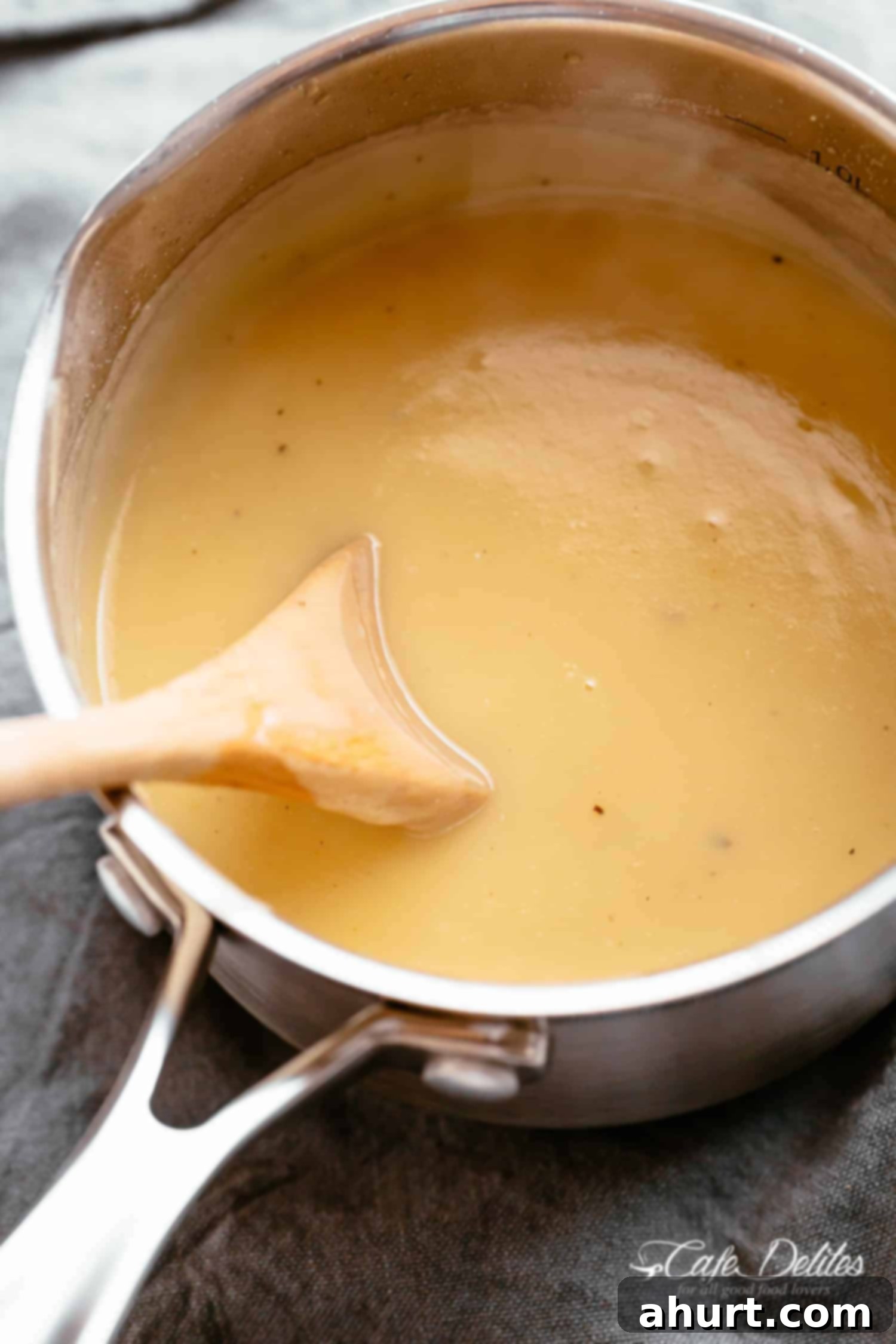The Ultimate Homemade Turkey Gravy: Rich, Easy & Flavorful Recipe
No roast dinner, especially Thanksgiving or Christmas, is truly complete without a generous pour of rich, homemade Turkey Gravy. Forget bland, store-bought alternatives; our recipe is designed to be quick, incredibly easy, and bursting with flavor. Whether you’re making it with those precious, savory pan drippings from your Roast Turkey or Garlic Herb Butter Roast Chicken, or using high-quality stock as a base, this gravy promises to elevate every bite. The depth of flavor infused into every spoonful is simply incomparable, transforming any meal into a gourmet experience.
With just five minutes of active prep, you can create a truly luxurious and flavorful gravy that will impress everyone at your table. It’s so much more rewarding and delicious than anything you’ll find in a can or packet.
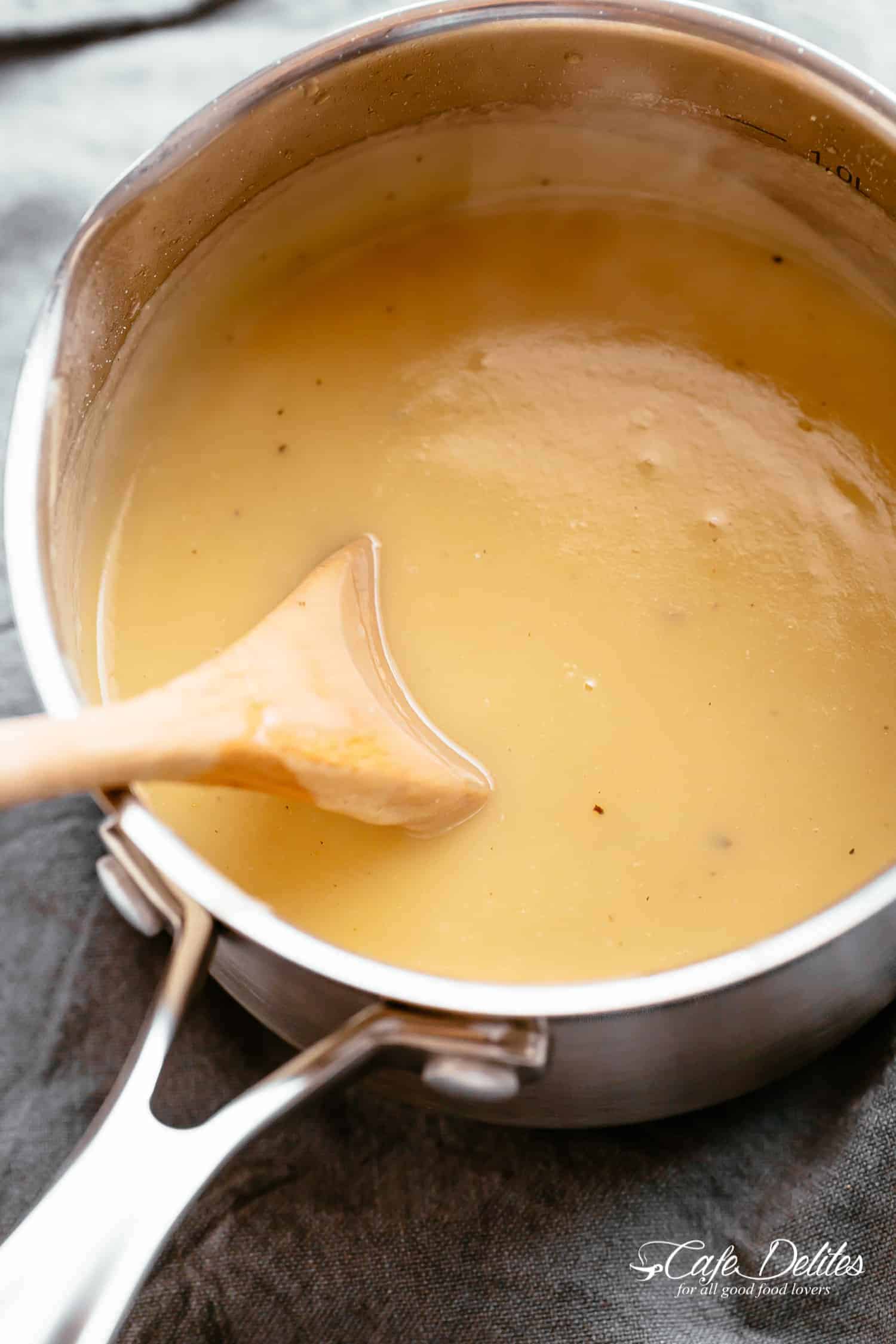
Why Homemade Gravy Reigns Supreme
There’s a profound satisfaction in drizzling a rich, homemade gravy over your holiday feast or Sunday roast. Nothing quite compares to the depth of flavor you get from a gravy made from scratch. This isn’t just about avoiding canned convenience; it’s about crafting a sauce that complements and enhances every element on your plate. A good gravy acts as a bridge, tying together the savory notes of the meat with the earthy goodness of vegetables and the comforting fluff of mashed potatoes. It’s a classic for a reason, and once you try this recipe, you’ll understand why it’s worth those few extra minutes.
The browned bits and flavorful scrapings left at the bottom of your roasting pan after cooking a succulent Roast Turkey or Roast Chicken might seem like mere leftovers at first glance. However, these drippings are pure culinary gold – a true Thanksgiving (or any celebration) gift! They are concentrated flavors from your roast, packed with savory goodness that forms the backbone of an exceptional gravy. Even if you don’t have drippings, a good quality stock ensures a delicious result.
How to Make Turkey Gravy (or Chicken Gravy)
Whether you’ve prepared a whole roasted chicken or a festive turkey, a truly rich and flavorful gravy is just minutes away. This recipe uses minimal ingredients and effort, delivering maximum impact. The process is straightforward, focusing on building layers of flavor and achieving the perfect silky smooth texture.
Essential Ingredients for the Best Gravy
To create this irresistible gravy, you’ll need just a few key components:
- Unsalted Butter: Using unsalted butter allows you to control the overall saltiness, especially since pan drippings and stock can vary in sodium content.
- All-Purpose Flour: This is the thickening agent that, when combined with butter, forms the essential roux.
- Worcestershire Sauce: A secret weapon for adding a deep, savory, umami note that enhances the meat flavors without overpowering them.
- Freshly Cracked Black Pepper: For a touch of warmth and mild spice.
- Turkey or Chicken Pan Drippings (or Stock): The heart and soul of your gravy. If pan drippings are scarce or you’re starting from scratch, a good quality turkey or chicken stock works wonderfully.
- Salt (to taste): Only add at the very end, as your drippings/stock may already provide enough seasoning.
With these simple ingredients, you’re well on your way to making the perfect Thanksgiving turkey gravy!
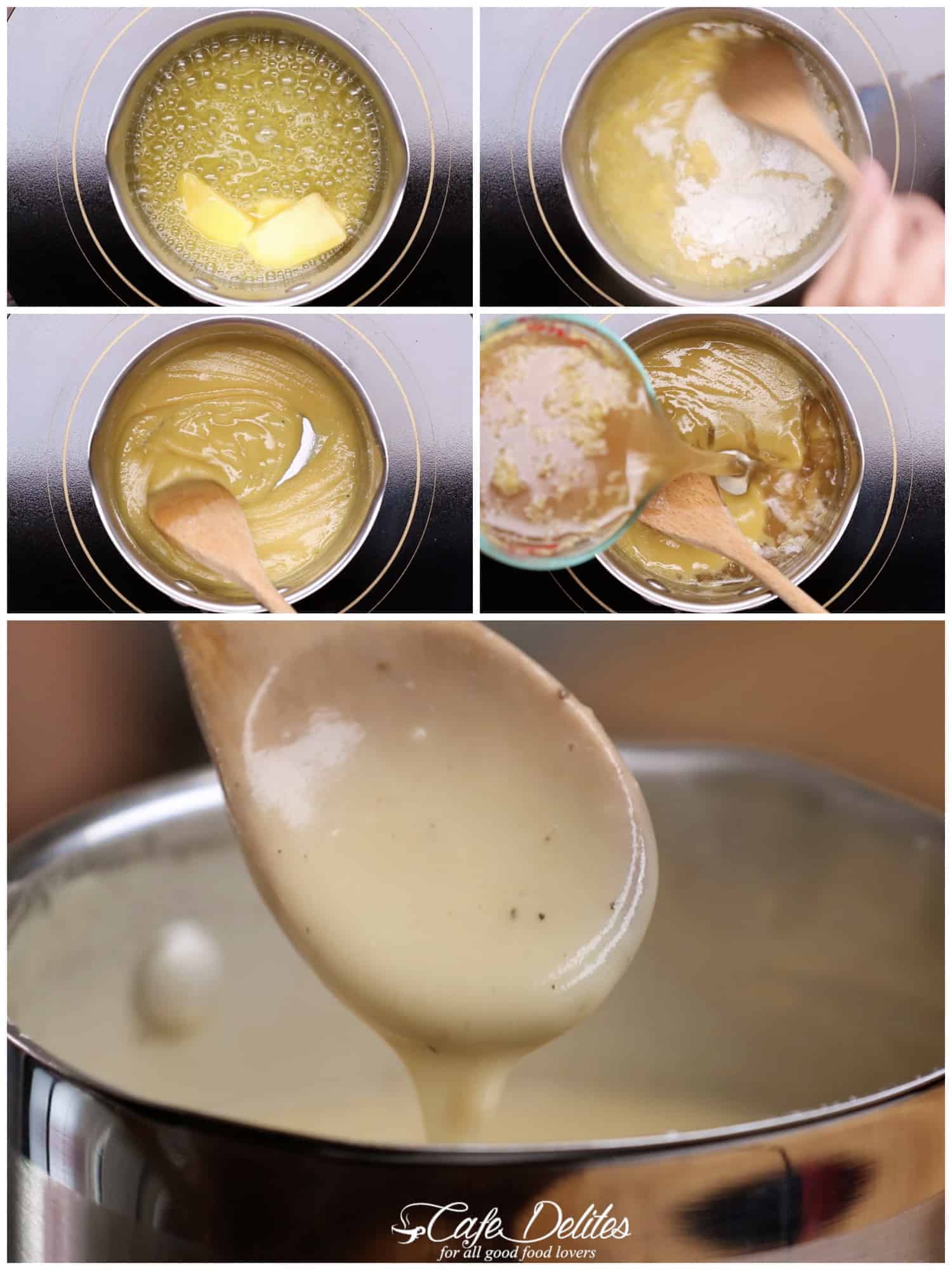
Mastering the Roux Gravy Technique
This recipe relies on a classic roux to achieve its perfect consistency and rich mouthfeel. While we adore making our turkey gravy fresh just before serving, it’s also perfectly possible to prepare it ahead of time. Simply warm it up gently right before dinner, adding a splash of extra stock or water if it has thickened too much.
- Prepare Your Pan Drippings: First, carefully pour your pan drippings into a fat separator or a heatproof measuring cup. Allow the fat to separate and rise to the top. Skim off most of the fat, leaving just a tablespoon or two along with the flavorful juices. Use a metal spatula or wooden spoon to scrape any browned bits of meat or vegetables stuck to the bottom of the roasting pan. These caramelized bits, known as ‘fond,’ are packed with incredible flavor and are essential for a truly rich gravy. Strain the liquid through a fine-mesh sieve to remove any solids, ensuring a smooth gravy.
- Melt Butter and Create the Roux: In a small saucepan or pot, melt the unsalted butter over low-medium heat. Once the butter is fully melted and slightly bubbling, whisk in the flour. This combination of fat and flour is your roux. Cook the roux for about one to two minutes, continuously whisking. You’re looking for it to transform into a pale, golden paste and develop a pleasant, nutty aroma. Be careful not to burn it!
- Gradually Add Liquid: This is a crucial step for a smooth, lump-free gravy. Slowly pour in your strained pan drippings, starting with about half a cup. Whisk vigorously as you add the liquid to prevent lumps from forming. Continue adding the remaining pan drippings in small increments (about 1/2 cup at a time), whisking well after each addition, until you achieve your desired texture. If you don’t have enough pan drippings, simply top up the liquid with good quality chicken or turkey stock until you have approximately 2 1/4 cups of total liquid. We prefer our gravy a little thicker, so we aim for this amount. Remember: it’s easier to thin out a thick gravy with a little more liquid than it is to thicken a watery one.
- Simmer and Thicken: Once all the liquid is incorporated and the gravy is smooth, bring it to a gentle simmer over medium heat. Allow it to simmer for a few minutes, stirring occasionally, until it thickens to your preferred consistency.
- Season and Finish: Remove the gravy from the heat. Stir in the Worcestershire sauce for an extra layer of savory depth. Taste the gravy before adding any additional seasoning. Pan drippings and stock can vary greatly in saltiness, so it’s important to taste first. Add salt and freshly cracked black pepper only if needed. For extra flavor, you can also stir in a pinch of dried herbs like sage or thyme, or a tiny dash of garlic powder, but usually, the drippings provide enough flavor on their own.
Your perfect homemade gravy is now ready to serve!
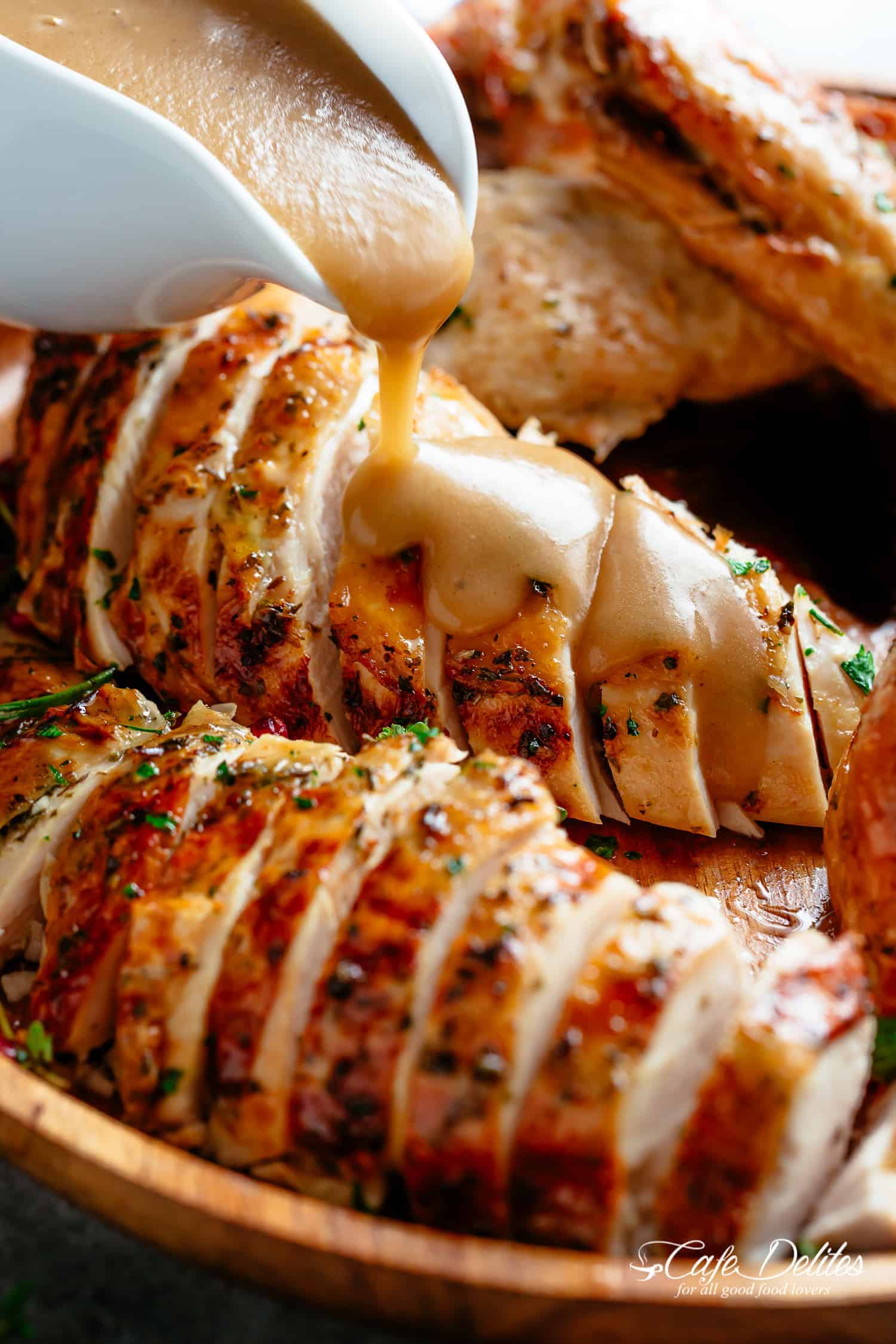
What is a Roux and Why is it Important?
A roux (pronounced “roo”) is a fundamental thickening agent in classical cooking, made by cooking equal parts fat (like butter, oil, or drippings) and flour together. It forms the base for many sauces, gravies, and soups, including our delicious turkey gravy. Think of it as the starting point for creamy homemade Béchamel sauce (white sauce), cheese sauce, or even richer, darker gumbos.
For our turkey gravy, a classic roux recipe typically calls for a 1:1 ratio of butter to flour, such as 1/4 cup butter to 1/4 cup flour. Cooking the roux for a minute or two develops a light, nutty flavor and removes the raw flour taste. The longer you cook a roux, the darker it becomes, and the less thickening power it has, but the deeper its flavor. For gravy, a light, golden or ‘blond’ roux is usually preferred, as it thickens effectively and allows the rich flavors of the pan drippings to shine.
Since our turkey gravy uses a roux, it’s important to remember that it will continue to thicken slightly as it cools. If you find your gravy has become too thick after resting, simply whisk in a little more warm stock, water, or even milk (for a creamier finish) just before serving until it reaches your desired consistency.
Generally, gravy made with authentic pan drippings requires minimal additional seasoning because those precious juices already contain all the rich savory flavors, salt, and pepper from the roasted bird. It’s always crucial to taste test your gravy once it’s finished cooking. This allows you to adjust the seasoning precisely, adding salt, pepper, or other herbs only if genuinely needed, ensuring a perfectly balanced flavor profile.
Gravy Troubleshooting & Tips for Success
- Lumpy Gravy: The most common issue! To avoid lumps, always add your liquid gradually and whisk continuously and vigorously. Start with a small amount of liquid to create a paste, then slowly add more. If you do end up with lumps, don’t despair! You can pour the gravy through a fine-mesh sieve or use an immersion blender to smooth it out.
- Too Thick: If your gravy becomes too thick, simply whisk in a tablespoon or two of warm chicken or turkey stock (or even water) at a time until it reaches your desired consistency.
- Too Thin: If your gravy is too thin, you have a few options. You can continue to simmer it gently over low heat, allowing it to reduce and thicken naturally. Alternatively, you can make a quick slurry by mixing a teaspoon of cornstarch with a tablespoon of cold water, then whisking it into the simmering gravy. Let it cook for another minute or two until thickened.
- Make-Ahead Gravy: You can absolutely make this gravy ahead of time! Prepare it as directed, then let it cool completely before storing it in an airtight container in the refrigerator for up to 3-4 days.
- Reheating: When ready to serve, gently reheat the gravy in a saucepan over low heat, whisking constantly. If it’s too thick, add a splash of stock or water to loosen it up.
- Freezing: Leftover gravy freezes well! Pour it into freezer-safe containers or bags and freeze for up to 3 months. Thaw in the refrigerator overnight and reheat as above.
What to Serve with Your Delicious Gravy
There’s nothing quite as comforting and satisfying as a warm, homemade, and incredibly delicious turkey gravy. It’s truly versatile and pairs perfectly with a myriad of dishes, making it an essential part of any festive meal or comforting dinner:
- Creamy Mashed Potatoes: The ultimate classic pairing. The gravy pools beautifully in mashed potato “volcanoes,” creating a dreamy bite. Try our Easy Creamy Mashed Potatoes for a perfect match.
- Sausage Meat Stuffing: Whether you prefer a savory bread stuffing or a traditional cornbread dressing, gravy adds moisture and an extra layer of flavor. Our Sausage Herb Stuffing is fantastic with it.
- Roasted Meats: Beyond turkey and chicken, this gravy is excellent with Roast Beef, pork loin, or even a simple grilled steak.
- Roasted Vegetables: Drizzle it over roasted Brussels sprouts, green beans, or carrots for a luxurious touch.
- Biscuits or Dinner Rolls: Perfect for soaking up every last drop of gravy!
- Meatloaf: Transform a classic meatloaf into something extraordinary with a generous ladle of homemade gravy.
- Open-Faced Sandwiches: Use leftovers to create delicious hot turkey or chicken sandwiches, smothered in warm gravy.
Whatever your preference, this homemade gravy is sure to be a star on your table, bringing comfort and incredible flavor to all your favorite dishes!
How To Make Gravy: Watch the Video
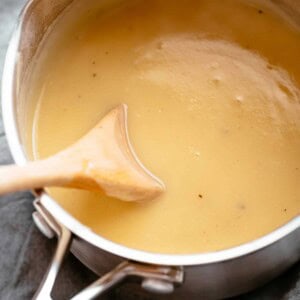
Saved
Pin
Turkey Gravy Recipe
Karina
5 minutes
10 minutes
15 minutes
6
people
Ingredients
Homemade Gravy
-
2 1/2
cups
pan juices
top up with chicken stock if needed -
1/4
cup
butter -
1/4
cup
flour -
1
teaspoon
Worcestershire sauce -
1
pinch
salt
if needed -
1
pinch
pepper
if needed
Instructions
-
Melt the butter in a small pot over low-medium heat. Whisk in the flour and allow to cook for about a minute or two, while whisking.
-
Pour in 1/2 cup of the pan juices from Roast Turkey or Roast Chicken and whisk until it forms a paste. Add remaining liquid in 1/2 cup increments, whisking in between, until the gravy is smooth.
-
Allow to simmer over medium heat until thickened. Take off heat, stir in Worcestershire sauce and season with salt and pepper (if needed).
The gravy will continue to thicken as it cools.
Notes
Nutrition
Calories:
124
kcal
|
Carbohydrates:
8
g
|
Protein:
3
g
|
Fat:
9
g
|
Saturated Fat:
5
g
|
Polyunsaturated Fat:
1
g
|
Monounsaturated Fat:
3
g
|
Trans Fat:
0.3
g
|
Cholesterol:
23
mg
|
Sodium:
223
mg
|
Potassium:
121
mg
|
Fiber:
0.1
g
|
Sugar:
2
g
|
Vitamin A:
240
IU
|
Vitamin C:
0.3
mg
|
Calcium:
7
mg
|
Iron:
1
mg
Nutrition information is automatically calculated, so should only be used as an approximation.
Tried this? Leave a comment below!
Frequently Asked Questions (FAQs) About Homemade Gravy
- Can I make turkey gravy without pan drippings?
- Absolutely! If you don’t have pan drippings, you can use high-quality turkey or chicken stock as the base. You might want to add a tablespoon of butter or oil to the roux to replicate the richness of the drippings.
- How do I prevent lumpy gravy?
- The key is gradual liquid addition and constant whisking. When adding the stock or drippings to the roux, start with a small amount (about 1/2 cup) to create a smooth paste, then slowly whisk in the rest. Using a fine-mesh sieve to strain the drippings beforehand also helps remove any solids that could cause lumps.
- Can I use cornstarch instead of flour for thickening?
- Yes, you can. Cornstarch creates a very clear, glossy gravy. To use it, create a “slurry” by mixing equal parts cornstarch and cold water (e.g., 1 tablespoon cornstarch with 1 tablespoon water). Whisk this slurry into your hot liquid at the end, stirring until it thickens. Be aware that cornstarch-thickened gravy can become thinner when reheated.
- How long does homemade turkey gravy last?
- Homemade gravy can be stored in an airtight container in the refrigerator for 3-4 days. For longer storage, it can be frozen for up to 3 months. Thaw overnight in the refrigerator before reheating gently on the stove.
- What’s the best way to get all the flavorful bits from the roasting pan?
- After removing your roast, place the pan on the stovetop over medium heat. Add a splash of stock, wine, or water to the pan and use a wooden spoon or metal spatula to scrape up all the browned, caramelized bits (the “fond”) from the bottom. This process is called deglazing and infuses your drippings with maximum flavor.
Conclusion: Your Best Gravy Yet Awaits!
Making homemade turkey gravy might seem like an extra step, but the results are undeniably worth it. This recipe provides a simple, foolproof method to create a rich, smooth, and deeply flavorful gravy that will become a staple at your holiday feasts and everyday roasts. Its versatility, ease of preparation, and superior taste will quickly make it a family favorite. So, roll up your sleeves, gather those precious pan drippings, and get ready to enjoy the ultimate homemade turkey gravy – a true testament to the joy of cooking from scratch. Enjoy every delicious, savory drop!
